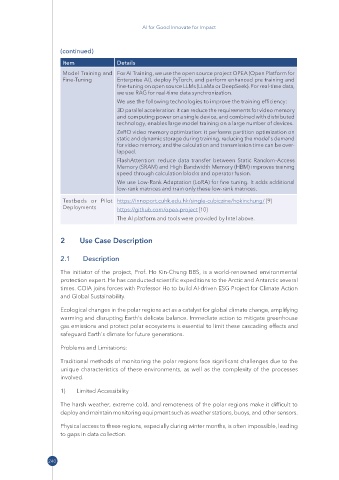Page 276 - AI for Good Innovate for Impact
P. 276
AI for Good Innovate for Impact
(continued)
Item Details
Model Training and For AI Training, we use the open source project OPEA (Open Platform for
Fine-Tuning Enterprise AI), deploy PyTorch, and perform enhanced pre training and
fine-tuning on open source LLMs (LLaMa or DeepSeek). For real-time data,
we use RAG for real-time data synchronization.
We use the following technologies to improve the training efficiency:
3D parallel acceleration: it can reduce the requirements for video memory
and computing power on a single device, and combined with distributed
technology, enables large model training on a large number of devices.
ZeRO video memory optimization: it performs partition optimization on
static and dynamic storage during training, reducing the model's demand
for video memory, and the calculation and transmission time can be over-
lapped.
FlashAttention: reduce data transfer between Static Random-Access
Memory (SRAM) and High Bandwidth Memory (HBM) improves training
speed through calculation blocks and operator fusion.
We use Low-Rank Adaptation (LoRA) for fine tuning. It adds additional
low-rank matrices and train only these low-rank matrices.
Testbeds or Pilot https:// innoport .cuhk .edu .hk/ single -cubiczine/ hokinchung/ [9]
Deployments https:// github .com/ opea -project [10]
The AI platform and tools were provided by Intel above.
2 Use Case Description
2�1 Description
The initiator of the project, Prof. Ho Kin-Chung BBS, is a world-renowned environmental
protection expert. He has conducted scientific expeditions to the Arctic and Antarctic several
times. COIA joins forces with Professor Ho to build AI-driven ESG Project for Climate Action
and Global Sustainability.
Ecological changes in the polar regions act as a catalyst for global climate change, amplifying
warming and disrupting Earth's delicate balance. Immediate action to mitigate greenhouse
gas emissions and protect polar ecosystems is essential to limit these cascading effects and
safeguard Earth's climate for future generations.
Problems and Limitations:
Traditional methods of monitoring the polar regions face significant challenges due to the
unique characteristics of these environments, as well as the complexity of the processes
involved.
1) Limited Accessibility
The harsh weather, extreme cold, and remoteness of the polar regions make it difficult to
deploy and maintain monitoring equipment such as weather stations, buoys, and other sensors.
Physical access to these regions, especially during winter months, is often impossible, leading
to gaps in data collection.
240

